
Understanding El Niño: A Climate Phenomenon
El Niño is a complex climate pattern resulting from variations in ocean temperatures in the Equatorial Pacific. Traditionally occurring every 2 to 7 years, this phenomenon disrupts normal weather patterns, particularly in tropical regions. During an El Niño event, trade winds weaken, which allows warm water to collect in the Central and Eastern Pacific. This shift alters precipitation patterns, often causing severe weather conditions such as droughts in regions like Australia and heavy rains in the Americas. Understanding El Niño involves studying these ocean-atmosphere interactions to better predict its onset and duration. Scientists utilize sophisticated climate models for this purpose, aiming to mitigate the adverse impacts connected to El Niño events, impacting agriculture, water supply, and various ecosystems across the globe.
Historical Impacts of El Niño on Water Systems
Throughout history, El Niño events have significantly disrupted water systems across the globe. By altering the global water cycle, these climatic shifts have caused both flooding and droughts. For instance, the 1982-1983 El Niño was one of the strongest on record, leading to catastrophic weather events worldwide, including severe droughts in Australia and devastating floods in South America. Water-dependent sectors, such as agriculture and hydropower, faced challenges due to unpredictable water availability, leading to economic and social stress. Communities reliant on consistent rainfall and river flows experienced acute shortages or damaging excesses, necessitating emergency management and long-term adaptation strategies. Historical analysis of El Niño events provides valuable insights into its recurring influence on water systems, fostering a deeper understanding of how to anticipate and adapt to future occurrences.
Mechanisms Linking El Niño and Water Resources
El Niño impacts water resources through a variety of atmospheric and oceanic mechanisms. With shifts in ocean temperatures, atmospheric pressure changes also occur, resulting in altered wind patterns. These changes can lead to increased evaporation rates and altered precipitation distribution. Regions typically experiencing regular rainfall may face droughts during El Niño, while areas usually dry may see significant rainfall increases, affecting freshwater availability and quality. Coastal regions may encounter changes in sea level, impacting freshwater reserves. Studying these mechanisms is crucial for developing robust prediction models that can inform water management practices. Improved predictive capabilities enable resource managers and policymakers to devise strategic plans to mitigate water-related impacts, ensuring communities are better equipped to handle the uncertainties El Niño events present.
Case Studies: El Niño’s Effects on Global Water Supply
Several case studies highlight El Niño’s profound effects on global water supply. During the 1997-1998 event, Peru experienced disastrous flooding due to unprecedented rainfall, severely affecting agriculture and housing. Conversely, Indonesia suffered drought conditions, leading to forest fires and water shortages. In the United States, shifts in river flow patterns were recorded, affecting both water supply and hydropower generation. These case studies underscore the necessity for region-specific adaptation strategies in response to El Niño-induced anomalies. By examining past events, researchers have learned to anticipate potential disruptions to water supply systems, promoting the development of advanced management approaches to minimize negative outcomes. Through these studies, the vulnerabilities of water supplies to climatic variances are better understood, supporting a proactive stance in water resource management.
Strategies for Mitigating El Niño-Induced Water Issues
Effective strategies for mitigating El Niño-induced water issues focus on enhancing resilience and improving adaptive capacity. Implementing comprehensive water management plans that incorporate efficient usage, storage, and conservation techniques is essential. Utilizing advanced climate forecasting tools, communities can anticipate water supply changes and adjust their practices accordingly. Diversification of water sources, such as integrating recycled water and rainwater harvesting, reduces dependency on traditional supplies. Investments in infrastructure, such as reservoirs and flood control systems, alleviate the impacts of fluctuating water availability. Education and awareness campaigns empower communities to adopt conservation practices and prepare for potential water-related emergencies. Collaborative approaches involving governments, scientists, and local communities ensure tailored strategies that address specific regional challenges posed by El Niño.
Future Predictions: El Niño and Water Security
The future of El Niño and its impact on water security remains a critical area of research. As climate change influences global weather patterns, the frequency and intensity of El Niño events may shift, adding complexity to water resource management. Advancements in climate science are enhancing predictive models, offering better foresight into El Niño’s evolution. These predictions enable proactive measures, facilitating the sustainable management of water resources. Policymakers are urged to integrate these insights into comprehensive planning, ensuring water security in the face of uncertainties. Collaborative efforts in research, technological innovation, and policy development are crucial to addressing potential challenges effectively. Understanding this climate phenomenon’s future trajectory aids in securing water supply systems, safeguarding against the variability El Niño may bring.
